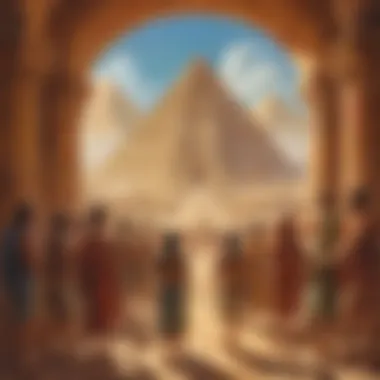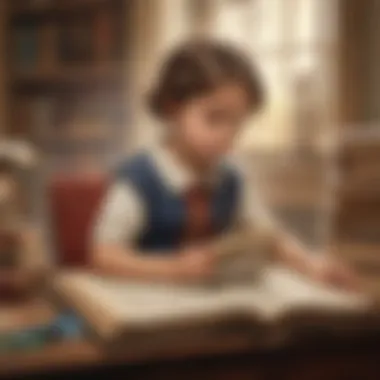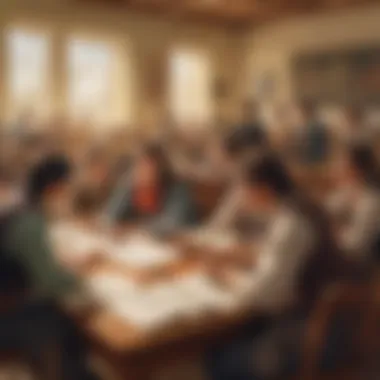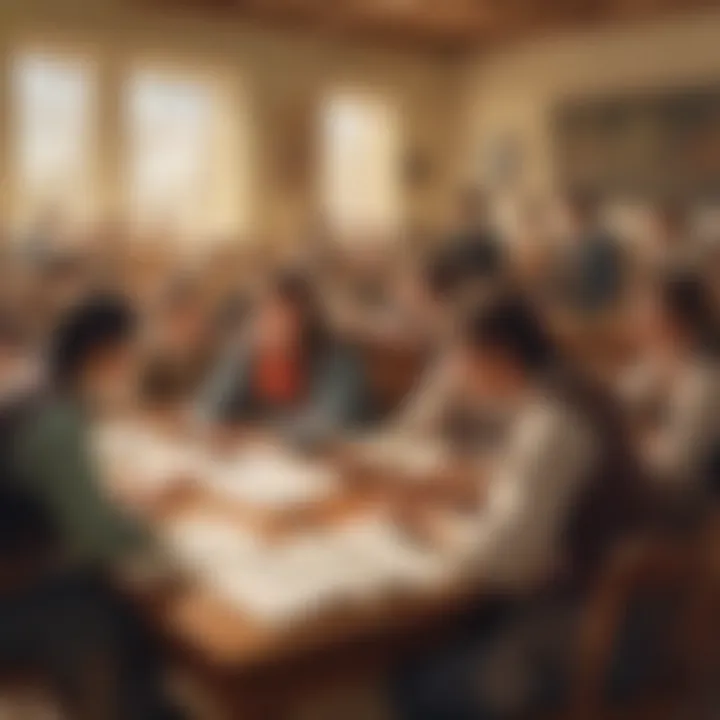Top History Books Every 5th Grader Should Read


Intro
Exploring history can be like stepping into a time machine, especially for 5th graders who are just beginning to grasp the intricate layers of the past. As children grow, their minds become fertile ground for captivating stories and enlightening narratives that provide context to the world around them. In this guide, we're not just suggesting a list of books; we're unearthing gems that will engage young readers, nurturing their curiosity and inspiring their imagination.
Parent and educators can play a pivotal role in this journey. By selecting the right history books, they can spark discussions at the dinner table, encourage questions about historical figures, and cultivate a deeper understanding of societal development through the ages. From tales of ancient civilizations to the explorations of modern history, there are countless opportunities to turn pages into portals of discovery.
This guide will navigate through essential titles that not only tell stories but also elicit critical thinking and foster a love for learning. Along the way, we'll tackle creative activities that complement these books and fun quizzes designed to reinforce knowledge. We aim to give you a solid framework to approach history books with confidence.
Let's unravel the treasure trove of history literature for our young minds, shaping them into informed global citizens.
Creative Activities
Engaging young learners goes beyond the pages of a book. Creative activities make history come alive and allow children to express what they've learned in fun and interactive ways. Here’s a dive into some ideas:
Craft Ideas
- Timeline Creation: Kids can use colored paper and markers to create a timeline of significant historical events. This can be displayed in their room or shared with classmates.
- Historical Character Masks: Encourage children to design masks representing key figures from their favorite history books. This fosters imaginative play while reinforcing character traits and stories.
- Artifact Replicas: Have children collect materials to recreate famous artifacts, like Egyptian hieroglyphs or Native American pottery. This gives a tactile experience that can deepen understanding.
Step-by-Step Guides
- Create a Timeline:
- Make a Mask:
- Build an Artifact:
- Gather materials: colored paper, scissors, glue, and markers.
- List historical events or figures from their reading.
- Arrange events chronologically, adding illustrations to each.
- Take a paper plate and cut out eye holes.
- Decorate with colors and designs that reflect the character.
- Attach a craft stick for holding.
- Use clay or play-dough to mold an artifact.
- Paint once dry to enhance detail.
- Share their creation and its historical significance with family or friends.
Educational Value
These hands-on activities promote critical thinking, creativity, and collaboration. They bolster retention, making facts stick better than any rote memorization could.
Fun Quizzes
Quizzes are an excellent way to bring interactive learning into the mix. They can both assess comprehension and provide a fun diversion. Let’s explore some quiz options that can be used:
Quiz Topics
- Famous Leaders Through History: Questions about their achievements and impact.
- Key Events of the 20th Century: Focusing on milestones and their global significance.
- World Cultures: Exploring diverse traditions and practices around the globe.
Question Types
- Multiple Choice: Offers a selection of answers, ideal for testing recall.
- True or False: Challenges understanding and prompts discussion.
- Fill in the Blanks: Encourages engagement with core concepts.
Knowledge Reinforcement
Quizzes help solidify information in memory, allowing young learners to not only recall facts but also make connections to broader themes in history.
Fact-Based Articles
In addition to books and quizzes, fact-based articles can supplement learning with bite-sized nuggets of information. Here’s what children can find:
Topics
- Inventions That Changed the World: Discusses pivotal inventions and their inventors.
- Historical Myths vs. Facts: Debunks common misconceptions.
- Exploration and Adventure: Chronicles significant journeys throughout history.
Engaging Content
Articles are often presented with vibrant visuals and straightforward language, making complex topics digestible. Short paragraphs and bullet points enable easy navigation, which is perfect for young readers.
Intro to History for Young Learners
History plays a vital part in shaping young minds. For 5th graders, learning about the past encourages critical thinking and curiosity. It offers them the chance to understand how their world has been formed. By recognizing historical events and perspectives, children can see the bigger picture—a tale of humanity that stretches across eras and continents.
One significant factor in introducing history at this age is that it begins to build their identity. Grasping where they come from and how various cultures have contributed to society can empower kids. If they understand the struggles and triumphs of those before them, it fosters resilience and appreciation for diversity.


Furthermore, learning history taps into imagination. When kids read about ancient civilizations, wars, or great leaders, they visualize the stories that shaped the world. This kind of education sparks creativity, allowing them to connect with events personally, rather than just through facts and dates.
In this section, we will delve into two key aspects of introducing history to young learners:
The Importance of History in Education
Utilizing history in education cultivates a sense of critical thinking. It teaches students to analyze sources and discern truth from opinion. A 5th grader encountering different perspectives is encouraged to ask questions such as, "Why did this happen?" or "Who benefits from this view?" This inquiry process helps develop reasoning skills crucial for their future education.
The exposure to history captivates young readers because it is not merely a set of timelines—it's a narrative full of drama, mystery, and relatable characters. For example, understanding the American Revolution isn’t just about knowing dates; it’s about hearing the voices of those involved, their fears, hopes, and dreams. That’s the kind of rich tapestry that grabs their attention and keeps them intrigued.
"History is not a burden on the memory but an illumination of the soul."
—Lord Acton
Role of Literature in Understanding History
Literature serves as a bridge between the past and present. History books provide context and depth to events that shaped human existence. For 5th graders, selecting the right history literature can transform dry facts into vibrant tales. Illustrated books, for instance, offer visuals that enhance understanding and retention of historical information. They make learning not just informative but an adventure in imagination.
Additionally, through characters in stories—whether they be children from ancient times or remarkable figures in history—readers can connect emotionally. This connection is pivotal. When a 5th grader reads about a girl who stood up for her rights or a boy who discovered new lands, they can see aspects of themselves in these characters. It inspires empathy and a personal engagement with history.
In sum, incorporating history into the curriculum for young learners is not just beneficial; it is essential. It's about building critical thinkers, fostering understanding, and drawing connections through literature. Through these lessons, they lay the foundation for a lifetime of appreciative learning and thoughtful engagement with the world.
Key Themes in History for 5th Graders
Understanding key themes in history is vital for young learners. It helps them connect historical events to their own lives and comprehend the complex world around them. Emphasizing themes allows children to see patterns and recognize the broader significance of events. Moreover, it helps make history relatable and engaging, instilling a sense of curiosity and growth.
American History Overview
The American history overview introduces scholars to the foundations of the United States, examining its origins, struggles, and triumphs. Kids often resonate with stories of bravery, such as those of the American Revolution. They learn how colonists fought for independence, which teaches them about resilience and determination.
- Key Events: The Revolutionary War, Civil War, and the Civil Rights Movement are pivotal points. Each of these events opens discussions about justice, equality, and the ongoing struggle for rights. Students can explore how the actions of individuals and groups shaped the nation.
- Cultural Growth: American history is also rich in cultural diversity. From Native Americans to immigrants throughout history, each group has contributed to the nation’s melting pot. This aspect enhances understanding of different viewpoints and backgrounds, and it can challenge young learners to think critically about their own identities.
In this realms, classics like "Number the Stars" by Lois Lowry offer a window into history through a narrative lens. Such books can deepen empathy towards those who faced hardship.
World History Highlights
World history offers a broad perspective on humanity's collective journey. It intertwines varied cultures and events that have shaped global societies. By examining world history, 5th graders begin to appreciate the interconnectedness of different people and ideas.
- Civilizations and Empires: Kids should delve into ancient Egypt, Greece, and Rome to understand early governance, philosophy, and arts. These societies are not just historical; they set the groundwork for many modern systems.
- Global Changes: Significant moments, such as the fall of the Berlin Wall or the Renaissance, can help illustrate how societies evolve. These highlights demonstrate shifts in power, culture, and thought, making history feel alive.
Illustrative books about landmark events can transport readers across time and place, taking them on an adventure through history.
Significant Historical Figures
Every narrative has its heroes and heroines, and history is no different. Spotlighting notable figures helps students see the challenges individuals can overcome. These stories provide role models while enriching the historical narrative.
- Visionaries: From George Washington to Marie Curie, these individuals made decisive impacts on their fields and society as a whole. Learning about them can inspire kids to pursue their passions and embrace their potential.
- Everyday People: Histories are not solely defined by famous personas. Stories of everyday people, like those involved in movements for change, can be equally inspiring. These accounts encourage young readers to appreciate their own ability to effect change in the world.
Many storytelling formats, including graphic novels, enrich these themes further.
Books can ignite imaginations and spark inquiries into the past. Encouraging this kind of curiosity early prepares children for a lifetime of exploration.
Selecting History Books for Young Readers
When it comes to giving young learners a taste of history, the selection of books can make or break their experience. Choosing the right history books for 5th graders is not just a matter of tossing a few titles in the air and seeing what sticks. It's about crafting a foundation for understanding the world around them, sparking curiosity, and igniting a passion for learning. The books selected should resonate with their interests and comprehension levels but also stretch their imaginations and challenge their thinking.
A sound selection process involves several specific elements. Factors such as age appropriateness, thematic relevance, and engaging narratives play key roles in ensuring that young readers not only read but also enjoy. This isn’t just reading for the sake of it; it’s building a bridge between past events and present realities.
Criteria for Book Selection
Some key criteria can guide parents and educators in selecting suitable history books for young readers:
- Relevance to Curriculum: Books that align with what students learn in school can reinforce their understanding and retention.
- Accuracy of Information: The facts should be correct and presented in an age-appropriate manner. Misinformation can sour the interest in the subject altogether.
- Diverse Perspectives: Selecting books that showcase various cultures and viewpoints gives a more rounded understanding of history.
- Engaging Writing Style: The language should be accessible yet stimulating, using illustrations, dialogues, or anecdotes to bring history to life.
- Critical Thinking Prompts: Good books don’t just present information; they encourage young readers to think, reflect, and ask questions about the events and their implications.
Adhering to these guidelines can help ensure that children develop a robust understanding of history while enjoying the books they read.
Understanding Age Appropriateness
Age appropriateness is crucial while choosing history books. At the 5th-grade level, children are beginning to move beyond simple narratives and into complex ideas. They are able to grasp themes like cause and effect, the importance of context, and the multifaceted nature of historical events.


Books should not only be appropriate in terms of vocabulary but also in the concepts they tackle. For example:
- A book might discuss war but in a way that focuses on the effects on families rather than graphic violence.
- Historical figures might be presented with emphasis on their achievements rather than solely their downfalls.
In addition, the length of the books should be manageable. Long, dense texts can be overwhelming and deter a child from diving deeper into the subject. Instead, engaging chapter books or illustrated history entries can provide both information and inspiration without becoming tedious.
Ultimately, selecting history books for young readers requires a meticulous approach, one that values both informative content and the ability to ignite a lifelong interest in history.
Recommendations for Engaging History Books
When guiding young minds through the dense forest of history, the right book can serve as a friendly compass. It’s essential to choose titles that not only educate but also spark interest. Engaging history books can light a fire of curiosity in fifth graders, encouraging them to delve deeper into the past and understand its relevance in today’s world. Here, we’ll take a closer look at various categories of recommended titles that fulfill these needs, giving students multiple paths to explore history.
Classic History Titles
Classic history books have an enduring appeal, often enchanting young readers with their timeless narratives and rich storytelling. These titles not only provide factual knowledge but also keep the reader at the edge of their seat as they uncover the threads of humanity's story.
Here are some standout classic titles:
- "A Little History of the World" by E.H. Gombrich
This book offers a grand overview from the Stone Age to modern times, all wrapped in an accessible manner. Gombrich’s storytelling connects events like a series of exciting adventures. - "The Story of the World" by Susan Wise Bauer
This multi-volume series tells history as a continuous story. It engages children with tales of kings, queens, battles, and discoveries. - "The American Revolution: A History" by Gordon S. Wood
deconstructions of the American Revolution present a gripping account that makes the past relatable. It shows young readers that history is far from boring.
Classic books resonate with a sense of nostalgia and authenticity, making history feel alive and accessible. The pages are filled with tales that teach lessons and provide context, showing readers the humanity behind the events.
Contemporary Works
Contemporary works bring fresh perspectives and often reflect recent research and discussions. These books highlight a broader understanding of history, often unveiling stories and voices that earlier texts may have overlooked. This is crucial for young learners who need to see themselves represented in history.
Some notable contemporary titles include:
- "I Am Malala: How One Girl Stood Up for Education and Changed the World" by Malala Yousafzai
This is not just a biography; it’s a story of courage that inspires young readers to appreciate their rights and the importance of education. - "The Crossroads: A Story of the Haitian Revolution" by J.B. Eddins
This engaging tale transports readers to the heart of a pivotal moment, blending narrative with action while educating about colonialism and liberation. - "Hidden Figures: The American Dream and the Untold Story of the Black Women Mathematicians Who Helped Win the Space Race" by Margot Lee Shetterly This book explores the role of women who supported NASA with their mathematical talents, showing young minds the importance of diversity in all fields.
Through contemporary works, younger readers encounter history as a living, dynamic field, constantly reshaping as new voices and stories emerge.
Graphic Novels and Illustrated Books
Visual storytelling is a powerful tool, especially for younger audiences. Graphic novels and illustrated books can make historical content approachable and engaging. With vibrant artwork and succinct narratives, these formats capture the attention of even reluctant readers.
Consider these impressive titles:
- "March" by John Lewis
This graphic memoir provides an essential insight into the American Civil Rights Movement through the eyes of a key figure, inviting students to experience the struggles and triumphs firsthand. - "Persepolis" by Marjane Satrapi
Not only is this story enriching, but it also opens discussions about cultural differences and historical contexts, all wrapped in a captivating memoir format. - "The Photographer: Into War-Torn Afghanistan with Doctors Without Borders" by Emmanuel Guibert
This stunning graphic novel combines photography, storytelling, and art, introducing readers to the challenges faced in faraway places, making global history tangible.
Graphic novels and illustrated books cater to different learning styles, making history an accessible journey through imagery and concise narratives. They demonstrate that history is not just written in books; it can also be experienced visually, resonating with creativity and emotion.
"Engaging with history through diverse formats not only enriches knowledge but also fosters a deeper understanding of the narrative that shapes our world."
By incorporating various types of literature, students can find their niche in history. The recommended titles above not only present facts and dates but also open up conversations about the human experience, making history relatable and exciting for young learners.
The Benefits of Diverse Historical Perspectives
Understanding history is not just about dates and events; it involves a myriad of perspectives that shape how we view the past. For 5th graders, engaging with varied historical narratives is essential. This aspect of history books encourages empathy and critical thinking. It opens the door for young learners to explore how different cultures, ethnicities, and genders contribute to the tapestry of human experience.
Why is this Diversity Important?
Introducing diverse historical viewpoints helps children to grasp that history is not a monolithic story. Instead, it is a collection of voices, some loud and some soft, that have shaped societies globally. When children read books that include multi-faceted perspectives, they learn that their own interpretations can differ from others, fostering dialogue and respect.
"Diversity in historical narratives allows children to connect with various backgrounds, making the study of history relatable and intriguing."
Multi-Cultural Perspectives
History books that incorporate multi-cultural perspectives are invaluable for young readers. These books immerse students in stories from different cultures, revealing the uniqueness and richness of each narrative. For instance, a book that tells the tale of ancient Aztec civilization side by side with the perspectives of European explorers demonstrates contrasting worldviews. This not only enriches their knowledge but encourages them to appreciate cultural differences.
- Broader Understanding: Exposure to various cultures allows children to expand their worldview and understand their place in a global community.
- Relatable Stories: When young readers see characters that reflect their own backgrounds or those that differ significantly, it piques curiosity and enhances engagement.
- Fostering Empathy: By hearing the voices of individuals from diverse backgrounds, children develop a sense of empathy that can last a lifetime.
Gender Representation in History Books
The portrayal of gender in historical narratives is another critical aspect that shapes a child's understanding of the past. Traditional history often highlights male figures, sidelining the monumental contributions of women and non-binary individuals. To create a more balanced view, it is vital to include books that showcase the influences and achievements of women throughout history.
- Celebrating Women's Contributions: Exploring books that detail influential women, such as Harriet Tubman or Marie Curie, allows students to see that history isn't only made by men.
- Challenging Stereotypes: By reading about diverse gender experiences, children can confront and question existing stereotypes and biases.
- Encouraging Future Leaders: Learning about women and gender non-conforming figures in history can motivate young readers to pursue their own aspirations, showing them that anyone, regardless of gender, can impact the world.


In summary, diverse historical perspectives are not just beneficial; they are essential for nurturing well-rounded, informed, and empathetic individuals. As 5th graders explore these narratives, they become equipped to engage thoughtfully with the world around them.
Strategies for Encouraging Interest in History
Fostering an interest in history among young learners is crucial. It provides them the tools to understand their world and its complexities. Engaging young minds in history is like planting seeds in a garden. With the right attention and care, those seeds can flourish into a lifelong appreciation for the subject.
Interactive Learning Approaches
One effective way to spark curiosity about history is through interactive learning. This approach makes use of various hands-on activities that draw students into the narrative of history, rather than just having them read it in a textbook.
For instance, reenacting historical events can be a gripping experience for 5th graders. Imagine a classroom transformed into a scene from the American Revolution, where students can act out roles from George Washington to everyday soldiers. Students wear costumes and use props, bringing the past alive in a way that lectures never could.
You can also think about field trips to local museums or historical sites. These outings can enrich what kids read in their books and offer them tangible connections to the past. Engaging with artifacts or even meeting knowledgeable guides can heighten their interest. Take a day to visit places like the National Museum of American History or a local heritage center. Talking about what was seen during these trips afterward reinforces learnings and encourages discussions.
Another strategy is to incorporate technology. Today’s kids spend a lot of time on screens. Using educational apps or websites that feature interactive timelines and virtual tours can captivate them. Resources like Britannica can provide exciting visuals that complement their textbooks.
"When children interact with history, it becomes their own story, rather than just facts in a book."
Connecting History to Current Events
Another strategy to cultivate an interest in history is to tie it to current events. Many children often struggle to see the relevance of history in today’s world. By discussing and making connections between what has happened in the past and today’s happenings, we create a more relatable narrative.
For example, when a significant event occurs in the news, like an election or a social movement, educators can discuss the historical events that shaped society leading up to that moment. Children might learn about civil rights movements while watching recent protests or discussions in the media about social justice. By introducing parallel events, they can see the patterns in history.
Additionally, discussing figures like Helen Keller or Martin Luther King Jr. alongside modern activists can deepen their understanding of how history influences the present. Parents can engage in this conversation at home, perhaps around the dinner table, tying in family discussions with broader historical contexts.
Moreover, utilizing digital platforms like Reddit can connect kids with fellow learners discussing similar topics. Online forums often provide a wealth of ideas, debates, and resources that can make history seem more alive and relevant.
Ultimately, the goal is to show young learners that history is not just a series of isolated dates and events. Rather, it’s an ongoing story of human experience, one that they are a part of even today. By utilizing interactive methods and connecting the dots between the past and present, the interest in history can be sparked, ensuring that children not only learn about history but also enjoy the journey through it.
The Role of Parents and Educators
The role of parents and educators in shaping a child's understanding of history cannot be overstated. They act as the guiding hand, helping young learners navigate the vast ocean of historical knowledge. When parents take an active interest in their child's education, it sends a robust message about the value of learning. Similarly, educators provide structured environments where children can explore history in depth. Together, they help create a journey through time that's both educational and enjoyable.
Promoting Historical Literacy
Promoting historical literacy involves more than just having students read history books; it’s about encouraging them to think critically about past events and their implications. Parents can foster this understanding by discussing historical events at the dinner table or sharing stories about their own heritage. For instance, a simple family conversation about a grandparent's experiences during a significant historical event can bring history to life for a child.
Some effective methods for promoting historical literacy include:
- Encouraging Critical Thinking: Ask open-ended questions like, "What would you have done in this situation?" or "How do you think this event affects us today?"
- Connecting to Current Events: Relate historical stories to current news. A discussion about civil rights can easily connect to today’s social justice movements.
- Using Technology: Recommend interactive history websites or apps that can engage children more dynamically than a traditional book might.
By nurturing a culture of inquiry and discussion, both parents and educators help children not only absorb facts but also understand the why and how of historical events.
Creating a Supportive Learning Environment
Creating a supportive learning environment is crucial for fostering a genuine interest in history among young learners. This does not solely imply providing the right books or resources, but also involves creating spaces where children can explore history comfortably and confidently. A supportive atmosphere encourages children to ask questions, voice their opinions, and engage deeply with the material.
Some considerations for parents and educators include:
- Establishing a Reading Nook: A quiet, welcoming space filled with history books can entice kids to pick them up and read. Throw in a comfy chair and good lighting for extra appeal.
- Emphasizing Exploration: Take children on trips to historical sites, museums, or reenactment events. The hands-on experience strengthens their understanding of the past in a memorable way.
- Promoting Group Learning: Book clubs or history-related discussion groups among peers can provide a platform for children to share thoughts—and that social aspect can make learning much more appealing.
"When kids feel safe and supported, they are more likely to dive deep into history, seeking out the stories and connections that make the past resonate with their lives."
All in all, the collaboration between parents and educators plays a pivotal role in enhancing historical literacy and establishing a solid foundation for a lifelong appreciation of history.
Concluding Thoughts on History Education
As we wrap up our exploration of history books suited for 5th graders, it becomes clear that these readings serve as more than mere stories of the past. They act as vibrant windows into cultures, events, and ideas that have shaped our world today. Understanding history is crucial for young learners as it broadens their minds, encourages critical thinking, and helps them appreciate the journeys of those who came before them. In an ever-evolving society, the literature we provide today paves the way for thoughtful, informed citizens of tomorrow.
Future Trends in History Literature
Looking into the horizon of history literature for young readers, it's apparent that we are entering a dynamic phase. Schools and publishers alike are increasingly recognizing the need for engaging content that speaks to diverse audiences. Here are a few trends shaping the future of history books:
- Incorporation of Technology: Digital formats are rapidly gaining popularity, especially among younger audiences. E-books and interactive apps provide an avenue for immersive learning experiences.
- Diverse Narratives: There is a growing consciousness around including varied perspectives. Books that reflect experiences from multiple cultures will likely continue to flourish, ensuring a richer understanding of history.
- Focus on Critical Thinking: Upcoming titles are being crafted to encourage students not just to learn facts, but to analyze and interpret historical events in a deeper context.
- Graphic Novels and Visual Storytelling: The rise of graphic novels is prominent, making complex historical content accessible and enjoyable for children. For example, series like "March" by John Lewis effectively blend art with important historical narratives.
Fostering a Lifelong Interest in History
Instilling a love for history in children is not just a beneficial endeavor; it's an enriching journey. Here are some effective strategies that educators and parents can employ:
- Relatable Stories: Choose books that present history through personal stories. When young readers can connect emotionally with a historical figure—whether it's through heroic quests or everyday struggles—they're more likely to stay engaged.
- Discussion and Dialogue: Engage children in discussions about historical events and characters. Asking open-ended questions about what they read helps them to form their own opinions and connect more deeply.
- Connections to Modern Day: Help children draw parallels between historical events and contemporary issues. This not only reinforces their learning but also shows them the relevance of history in the present.
- Create a Learning Culture: Surround children with historical artifacts, documentaries, and field trips. When history becomes a part of their normal life rather than just a subject in school, it nurtures an enduring fascination.
"History isn't just part of the past; it's the foundation upon which we build our future."







